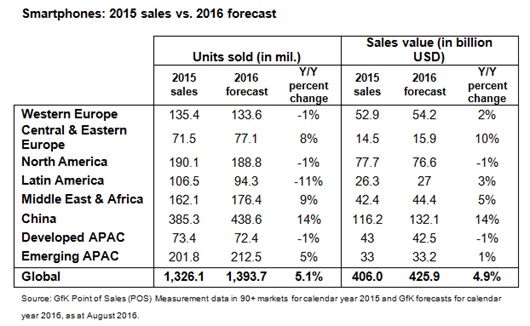New connected consumers in emerging markets, especially rural China, continued to drive smartphone growth in 2Q16, according to new research.
Analysis of the latest smartphone sales trends has prompted GfK to upgrade its forecast for the year.
Full year global smartphone sales value in 2016 has been increased from USD 400.7 billion to USD 426 billion, up five percent year-on-year. The cause is strong sales of mid-range to high-end units which has reversed the previous trend of low-end (
Kevin Walsh, director of trends and forecasting at GfK comments, “Volume growth is coming from many emerging markets, especially a resurgent China, but also Emerging Asia and Africa. We need to look beyond sales in the major cities and the shipments of global manufacturers to reveal this strong growth – since it is consumers in rural areas driving this demand. With China being a key part of the trend, it is not surprising that it is local vendors who are benefitting the most.”
North America: Consumers delaying upgrades to 4Q
Here smartphone demand totalled 42 million units in 2Q16, down five percent quarter-on-quarter and six percent year-on-year. Previous drivers of demand, such as the migration from feature to smartphone and 3G to 4G, are having less of an impact now that the high growth phase is over. In addition, churn rates have fallen in response to carrier’s retention strategies, including family plans.
The market will need to wait until 4Q for the next incremental driver of growth. It is in the last quarter of the year that major product launches are expected to have a higher impact, compared to 2015. Consumers that have been waiting for big launches will be ready to invest in upgrades.
Western Europe: Brexit fails to bite
Smartphone demand totalled 30 million in 2Q16, a fall of one percent quarter-on-quarter and also of one percent year-on year. The decline was felt most sharply in Spain, where demand declined 11 percent year-on year. This fall was a response to the country’s three leading operators raising their annual tariffs by an average of EUR 30. In the UK, demand declined two percent year-on-year in 2Q, showing no immediate impact from the vote in June to leave the European Union. Declines in these two countries were partially offset by three percent growth in France and one percent growth in Germany.
The share of demand for devices sized 5” and above increased significantly from 38 percent in 2Q15 to 60 percent in 2Q16. Correspondingly, the share of demand for high-end smartphones (USD 500+) increased from 31 percent in 2Q15 to 35 percent in 2Q16, with unit growth of 12 percent year-on-year. GfK forecasts that smartphone demand in the region will decline to 134 million units in 2016, a drop of one percent year-on-year.
Central and Eastern Europe: Growth finally returns to Russia and Ukraine
Smartphone demand hit 17 million units in 2Q16, down one percent quarter-on-quarter and up 12 percent year-on-year. Russia was a key driver of growth, up 12 percent year-on-year, following five quarters of decline. A release of pent-up demand in Ukraine lead to strong growth of 35 percent year-on-year following six consecutive quarters of decline. GfK forecasts that smartphone demand in the region will increase to 77 million units in 2016, up eight percent year-on-year.
Latin America: Brazil woes continue as Argentina remains buoyant
Here smartphone demand reached 23 million units in 2Q16, up five percent quarter-on-quarter, but down eight percent year-on-year. This regional decline was due to a fall in demand of 20 percent year-on-year in Brazil. Growth in Argentina remained high at 58 percent year-on-year, still buoyed by the removal of import restrictions in December last year. GfK forecasts that demand in the region will decline to 94 million units in 2016, a drop of 11 percent year-on-year.
Middle East and Africa: Saudi Arabia depresses regional growth
Here smartphone demand reached 41 million units in 2Q16, down two percent quarter-on-quarter, whilst year-on-year growth slowed to five percent. In Saudi Arabia, on-going macroeconomic weakness caused demand to decline by 24 percent year-on-year in 2Q. This decline offset growth of 19 percent in Egypt and 15 percent year-on-year in South Africa. GfK forecasts that smartphone demand in the region will grow to 176 million units in 2016, up nine percent year-on-year.
China: Rural sales drive highest growth for over two years
Smartphone demand totalled 109.7 million in 2Q16, giving a flat quarter-on-quarter, while growing 24 percent year-on-year. This year-on-year growth improved from 19 percent in 1Q16 and is the highest seen for over two years. The strong growth was driven primarily by continued operator subsidies (which began in early 2016), which helped drive strong 4G smartphone adoption in the smaller cities. Local brands have benefitted from growth outside the major cities, seeing their share of the country’s smartphone market increase from 74 percent in 2Q15 to 81 percent in 2Q16.
The shift to larger screen sizes continued, with 5”+ share increasing to 83 percent in the quarter, an impressive growth from 63 percent in 2Q15. GfK forecasts that smartphone demand growth in China will moderate in the second half of the year, bringing 2016 to 439 million units, up 14 percent year-on-year.
Developed APAC: Australian demand declines year-on-year
17 million units were sold in 2Q16, down 12 percent quarter-on-quarter and one percent year-on-year. Demand declined nine percent year-on-year in Australia but grew two percent in Japan in the same period. GfK forecasts that demand in the region will total 72 million units in 2016, a decline of one percent year-on-year.
Emerging APAC: Philippines and Vietnam post strong unit sales
Strong growth in both the Philippines (37 percent year-on-year) and Vietnam (11 percent year-on-year) helped the region grow overall demand by three percent quarter-on-quarter and four percent year-on-year to 51 million units. Indonesia saw a mild decline of 0.3 percent. GfK forecasts that demand in the region will reach 213 million units in 2016, a growth of five percent year-on-year.

Arndt Polifke, global director of telecom products at GfK concludes, “The smartphone market expanded yet again in 2Q16. This is despite many headwinds, demonstrating the underlying strength of the sector. Later this year, new product launches will further bolster demand. Further ahead, innovations such as extended battery life and foldable displays will support growth, as we progress towards 5G upgrades near the end of the decade.”
Source: www.gfk.com

